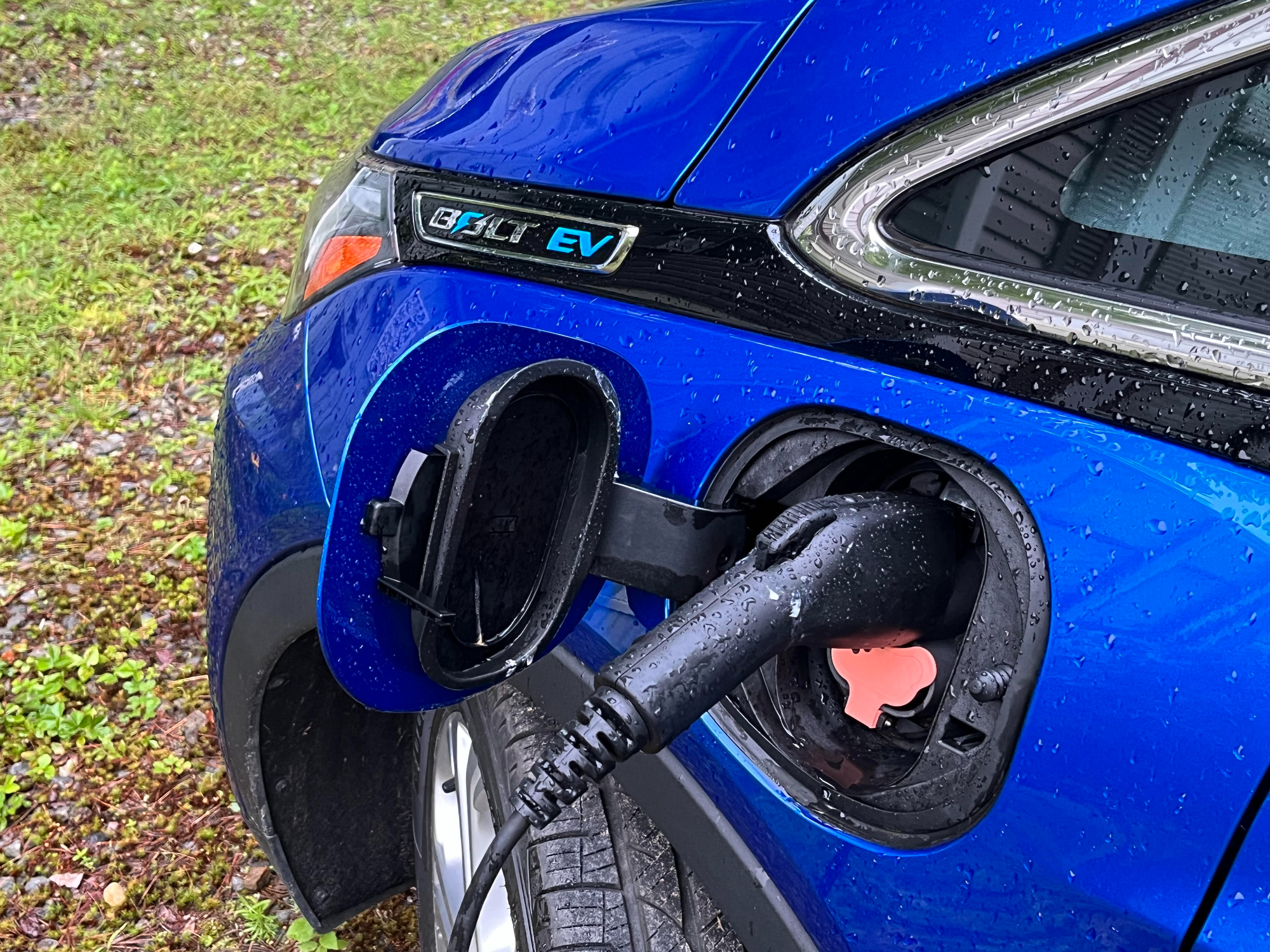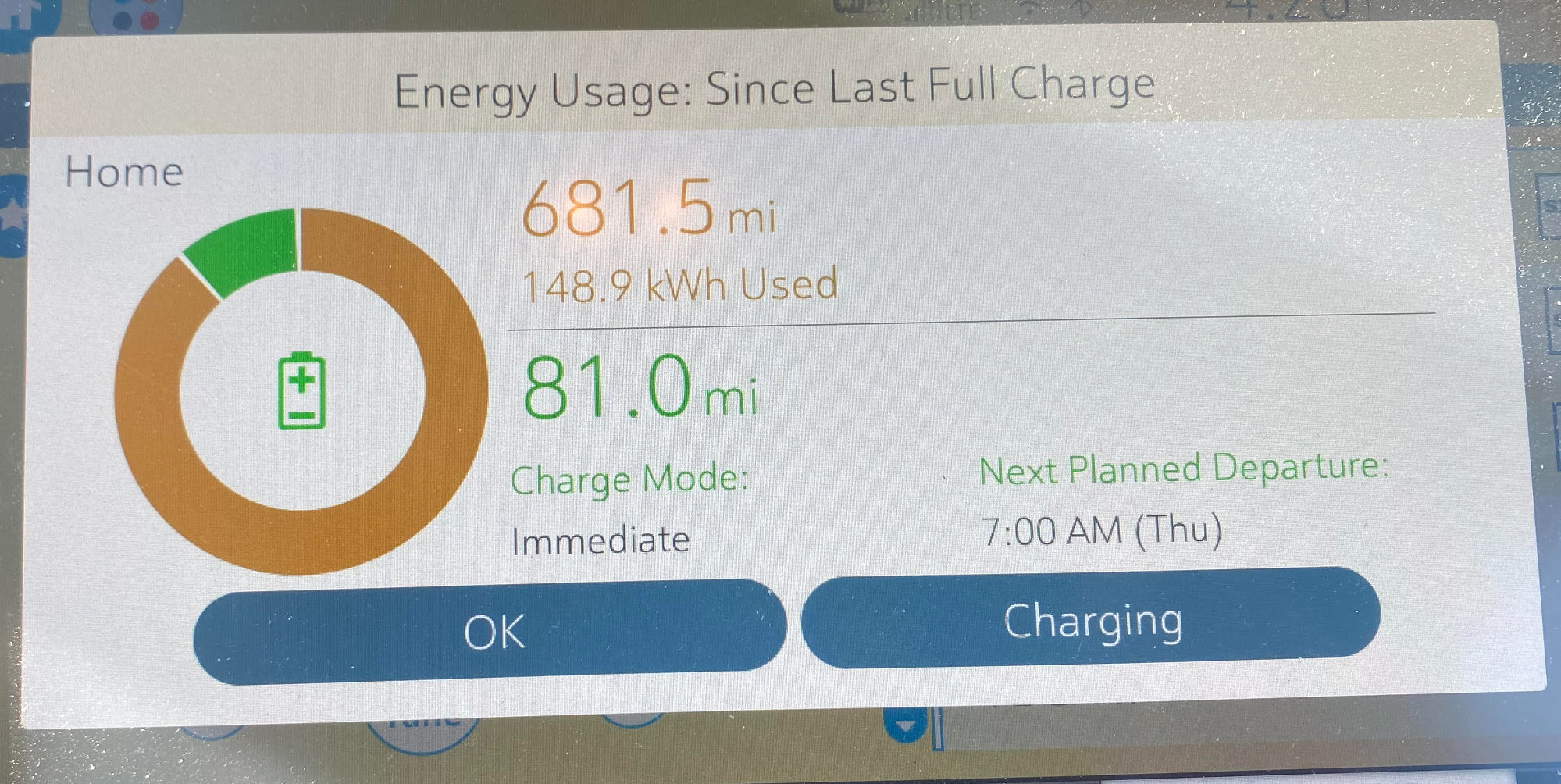
BlueB, the 2017 Chevy Bolt my wife and I bought in June, has served us well this summer, taking us on numerous vacations and trips to reconnect with friends. We put about 3000 miles on the car and used a ChargePoint Level 2 charger only once. The rest of the time, we relied on a simple wall outlet, which is what is known to EV drivers as Level 1 charging.
Level 1 Charging A Chevy Bolt

Photo by Carolyn Fortuna/ CleanTechnica
Let’s talk about charging an electric car, because that’s what causes the most anxiety among people thinking about purchasing one. Most people assume (we know what people say about that word, don’t we?) they will need to install charging equipment — commonly referred to as “electric vehicle supply equipment” or EVSE — where they live before they can own an EV. Doing so may involve significant expense, depending on a number of factors.
Not everyone understands electricity. I am not an electrician, nor have I ever played one on TV, but there are some basics you should be aware of. I like to compare an electrical circuit to a garden hose. Voltage is a measure of the pressure in the hose. The common voltage at a wall outlet in the US is 120 volts. That’s good but not great. You can use it to wash your car or water your petunias, but if you want the stream to go more than about 10 feet from the nozzle, you will need more pressure.
Using a 120 volt circuit to charge your electric car is known as Level 1 charging. In general, it draws about as much electricity as a window air conditioner and can add about 3 miles of range for every hour plugged in. That’s not very much, but for many people, it’s enough. If you drive under 36 miles on a normal day, your car will replace the electricity used during the day if it is plugged in for 12 hours overnight. You won’t need an EVSE to do it. Just plug in the charging cable that came with your car (or buy one online). No need to buy a charger or hire an electrician.
Relying on Level 1 charging does require a bit of management, however. Even the best EVs on the market won’t replenish their batteries if you don’t plug them in! And if you are driving longer distances once in a while, you will need to develop a strategy for charging while away from home. More on that in a minute.
Level 2 Charging
If you have a 240 volt outlet you can plug into, you can cut your charging time in half. 240 volt circuits have two 120 volt conductors, so it’s like having two garden hoses instead of one. Many homes have a 240 outlet somewhere near where most people park, but if you don’t, you will need to hire an electrician to install one for you. Here’s a tip. Some people report being charged extra if they say they are using the new circuit to charge an EV. Just tell the electrician you want to plug in a welder and the price may be less.
Now let’s talk about amperage, which is like the volume of water that can fit through your garden hose in a certain amount of time. A typical 20 amp 240 volt circuit is like using a 1/2″ hose and normal household pressure. But a 240 volt circuit can supply 30, 40, 50, 60, or even 80 amps of power.
The higher the amperage, the shorter your charging time will be. By the same token, an 80 amp circuit may cost you considerably more than a 20 amp circuit ($3,000 or more). You need to ask yourself how fast you need to charge your car. Having a spiffy 80 amp charger may give your bragging rights among your EV friends, but if your car typically sits unused for 10 to 12 hours overnight, why would you care whether it is fully charged at 9 pm instead of 6 am the next morning?
Once again, Level 1 charging may be all you need for 95% of your driving, and the rest can be provided by public chargers when necessary.
Level 3 Charging
Level 3 charging, also known as DC fast charging, is an option no home owner needs to consider. In comparison to a garden hose, it is a fire hose that can shove electrons into your battery at a furious pace. The best of them can add 50 miles of range or more in 15 minutes or less. The cheapest ones start at around $100,000 and may require extensive (and expensive) upgrades to your home’s electrical service. This is not an option any rational homeowner would consider, any more than you would buy a fire truck to water your pansies.
The Chevy Bolt & Charging Management
My wife and I added 3000 miles to BlueB, our 2017 Chevy Bolt, in 3 months. During that time, we only used a Level 2 public charger once. When we visited friends on Cape Cod, we simply plugged in to a wall outlet in their garage while we were there. For visiting friends who own a camper, we bought an adapter that let us plug in to their 30 amp camper power supply on the side of their garage.
There were no issues and never a moment when we had range anxiety. But that doesn’t mean there are not differences in how we plan our trips. We have all the charging apps and have instructed Google Maps to show us where charging stations are located. That being said, you don’t want to be sitting for hours at a Level 2 charger when you are traveling, and the number of Level 3 chargers in New England is depressingly small.
So challenges remain for EV drivers, especially if you want to take scenic Route 100 north through the green mountains of Vermont instead of staying on the interstate. And yet, there is something satisfying about needing to be resourceful in order to get where you are going and back again without drama in an electric car.
In a conventional car, you simply hit the road, knowing there will be gas stations wherever you go. Driving on electrons requires a little more thought, a little more planning, and a willingness to step outside your normal comfort zone in order to enjoy the pleasures of driving an electric car.
The Advantages Of An EV
Those pleasures include a silent ride, with no engine noise and no gnashing of gears. It really is amazing how quiet an electric car is. And it you find yourself dawdling along behind some leaf peeper on a county lane, it is good to know you can whoosh by in the blink of an eye when the opportunity arises. In an EV, passing is as easy as toeing the exhilarator and seeing that car in your rearview mirror a few seconds later.
Hills are also no challenge for an electric car. The electric motor just flattens them like they aren’t even there. There’s no shifting gears and no waiting. Just instant torque hustling you up and over the crest in a blink of an eye.
Regenerative braking is another feature EV drivers soon learn to enjoy. Release pressure on the go pedal and the car instantly begins to slow while putting some energy back into the battery. Release the pedal all the way and the rate of retardation increases. After about a week, you learn to modulate the pedal so the car comes to a stop at traffic lights just where it should. It soon becomes intuitive — and fun.

The Takeaway
Our Chevy Bolt has been a revelation. We also own a Tesla Model Y and sort of expected the Bolt to be a pale imitation, lacking in refinement and overall goodness. We were pleasantly surprised. The car rides beautifully. I actually think it handles bumps in the road better than the Tesla. The hatchback means we can fit all our stuff inside easily. It is comfortable and quiet.
There are a few nits to pick. The electric steering is not as precise as it could be. There is a lack of self-centering feel when exiting a turn, especially at slower speeds. The information screen has too many levels and is a bit fiddly to navigate.

Photo by Steve Hanley for CleanTechnica. All rights reserved.
Other than that, it is a fine car that has exceeded our expectations. We have no hesitation about recommending it to our friends. Over the past 3 months, it has averaged 5.5 miles per kWh in gentle driving around town and 4.5 miles per kWh on the highway, where it is driven so as to keep up with most traffic, not out in the high speed lane in a quest to break land speed records. The photo above shows usage after two back-to-back highway excursions.
We also have used the heater and air conditioning sparingly, having rediscovered the joy of driving with the windows open! It goes without saying the $4000 federal used EV tax credit will be much appreciated next April.
In my first report about our Chevy Bolt, I gave it 4.5 stars. After driving the car for 3 months and three thousand miles, I have decided to raise that to 4.675 stars. Is the Bolt perfect? No. Being a 2017 model, it is a half step behind the latest cars on the market. But it’s plenty good enough for us and will fit the needs of most American drivers.
The price is right, too. If you want to try an electric car without breaking the bank, a used Chevy Bolt that is eligible for the federal tax credit is an excellent choice. Just remember that tax credit is only available if you buy from a licensed dealer.
The used Chevy Bolt — Buy it. Drive it. Be happy!
I don’t like paywalls. You don’t like paywalls. Who likes paywalls? Here at CleanTechnica, we implemented a limited paywall for a while, but it always felt wrong — and it was always tough to decide what we should put behind there. In theory, your most exclusive and best content goes behind a paywall. But then fewer people read it! We just don’t like paywalls, and so we’ve decided to ditch ours. Unfortunately, the media business is still a tough, cut-throat business with tiny margins. It’s a never-ending Olympic challenge to stay above water or even perhaps — gasp — grow. So …




